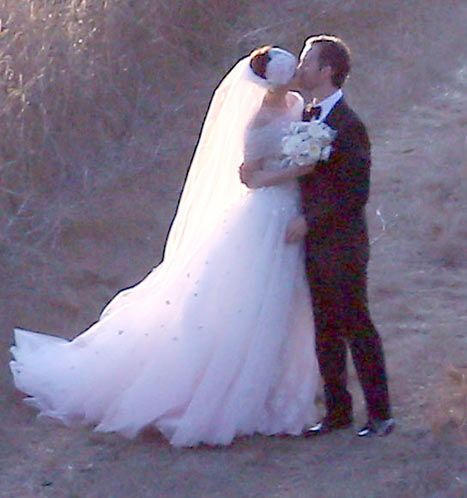|
查看原文
They haven’t always been white. With a new exhibition on bridal gowns opening at the V&A, Lindsay Baker investigates the trends and taboos of connubial chic.
It’s the default setting for brides in Western culture, but what does the ubiquitous white wedding dress actually represent? Not quite what we have always assumed, it turns out. The tradition of brides wearing white has never symbolised virginity or purity, according to a new exhibition that explores the garment’s history – the white bridal gown’s primary function was ostentatiousness.
“The connotation of purity was not important,” curator Edwina Ehrman tells BBC Culture. “It was about wealth. Throughout the 18th and 19th Century, women who could afford it got married in white.” In the days when washing was done painstakingly by hand with a washboard, a white dress was almost impossible to clean thoroughly. “It was a garment you just wore once, so it was only for the very wealthy.” The exhibition at London’s Victoria & Albert Museum, Wedding Dresses 1775-2014 shows how wedding dresses have changed in tune with fashion and society over the centuries – and also upends some of our long-held assumptions along the way.
The white (or ivory) wedding dress – popularised by Queen Victoria, who wore one at her wedding to Prince Albert in 1840 – has certainly endured. There’s no denying its totemic power. For many brides it encapsulates a hopeful, romantic nostalgia, and many designers. “It can have a transformative effect,” says Ehrman. “And if you’ve already been living with your partner or even if you’ve had children you may want to wear white at your wedding because you feel it marks a new phase in your relationship.”
White is the warmest colour
So quintessentially bridal has the white dress become that now when a bride chooses to tie the knot wearing another colour, it’s considered daring and rebellious: think burlesque dancer Dita Von Teese in her purple, corsetted dress by Vivienne Westwood, for instance; singer Gwen Stefani in a dramatic dip-dyed number by John Galliano; or actresses Anne Hathaway, Jessica Biel and Reese Witherspoon all of whom recently wed in unconventional pink. And when designers Oscar de la Renta and Vera Wang recently debuted non-white wedding-dress collections, it was viewed as a radical move in the conservative bridal-wear industry.
Yet getting married in pink, purple, yellow, red (the typical bridal gown colour in China) or any other colour for that matter is nothing new in Western culture, nor particularly irreverent, says Ehrman. “Over the centuries, brides who were interested in fashion have often got married in different colours. And they would wear them many times afterwards, altering them over the years to fit in with fashion, or to fit a changing figure.” And it was common for women not to buy a new dress for the occasion, but to simply get married in their best existing outfit.
Bridal fashion adapted to wartime as best it could. “People did what they could during World War II,” explains Ehrman. “They would borrow a dress or wear their service uniform. Women in the armed forces could also hire a dress, and some brides made dresses out of curtain fabric. We have an example in the show of a buttercup-print dress made of lightweight upholstery fabric.”
Post-war, the mid-calf ballerina-length design became popular, favoured by women who had careers. There were some spectacular one-off gowns, too. Margaret Whigam, one of the first It girls, wore a big, showy gown by Norman Hartnell. “She was beautiful, rich and she loved the camera – she was the perfect client for Hartnell,” says Ehrman. “That was not a garment that could be altered for another occasion.”
In the swinging 1960s, singer Lulu sported a white hooded, fur-trimmed maxi coat over a mini dress and high boots. The Thea Porter-designed empire-line dress displayed in the show – “demure but flirty” as Ehrman puts it – in devore velvet, is quintessentially 1970s. “The reason the white wedding dress has survived is because it can evolve and remain fashionable –it persists because it can be reinvented.”
Designer Jenny Packham agrees. “The most memorable wedding outfits for me are those that define an era from a fashion perspective,” she says. “Bianca Jagger in that white suit, Audrey Hepburn in a mini dress and head scarf.” Packham designs bridal wear as well as eveningwear (and is a favourite with many high-profile women, including the Duchess of Cambridge).
So what era influences Packham’s bridal wear the most? “The 1930s are always a great source of inspiration – a wonderfully decadent and glamorous era between the wars, it was a design explosion of divine proportions.”
And how does she predict the wedding dress will evolve? “The bridal dress must stand out as a piece of clothing… At the moment there is a comfortable stand-off between the red carpet and the aisle. Neither wants to look like the other.”
Alice Temperley, whose embellished Jean dress is displayed in the show, is influenced by the silhouettes and spirit of the 1920s. Why has the romantic, ultra-feminine gown endured for so long in her view? “The wedding dress is traditional, timeless and defies trends,” she says, recalling her own wedding dress, made with “antique lace and 1920s sequins that I had collected since childhood”.
Making a statement
It’s all in the detail, agrees Gareth Pugh, who has created stage outfits for the likes of Lady Gaga and Kylie Minogue – and whose dramatic-but-romantic bridal dress for stylist Katie Shillingford features in the exhibition. “A costume for the stage and a wedding dress both have very specific roles to fulfil,” Pugh tells BBC Culture. “However, the approach and process are very different. Usually with stage costume, comfort and the ability to move around easily are top of the list, along with being visually striking.
“With a wedding dress there are layers of subtlety that you can achieve that you just can’t replicate on stage – usually because a wedding dress is viewed in much closer quarters. And a bride is more willing to forego comfort.” And how does Pugh think the wedding dress will evolve in the future? “I think the idea of dressing up and presenting a side of oneself that is a fantasy will always appeal,” he says. “For most, a wedding is perhaps the one day where they are allowed free rein to really go to town. There will always be a niche market for the traditional white meringue, but I like the idea of the dress being a little more personal – something that is made with love and care, something that takes time and patience - a lot like the marriage itself.”
And like marriage itself, wedding attire continues to evolve. As Edwina Ehrman puts it, “Gay weddings and cross-cultural weddings are both examples of how new traditions are being established.” All of which feeds into the multi-billion-dollar global wedding-attire industry. “There is definitely a spirit of competitiveness around weddings now – the bridezilla or groomzilla phenomenon is real,” says Ehrman. And the alternative-wedding bridezilla who wishes to make a conscious statement through her wedding can be just as competitive – in fact, some are ditching the white wedding dress to make a point about gender politics.
That’s nonsensical, says Ehrman. “If you want to wear a coloured dress on your wedding day, or trousers, or go barefoot, go ahead. But the idea that wearing a white wedding dress is going to somehow enslave you is absurd – equality and respect are what matter in a marriage, not what you wear at your wedding. When it comes to modern bridal wear we are just incredibly lucky to have such a diversity of choice.”
|
查看譯文
婚紗并非自古就是白色。隨著V&A博物館里又一輪婚紗展覽的舉行,林賽·貝克(Lindsay baker)對婚禮服飾的流行趨勢和禁忌做了詳細的調查�����。
據英國廣播公司(BBC)報道,在西方文化中��,新娘身著白色婚紗已經成為一種約定俗成的模式,但如此流行的白色婚紗到底有什么樣的含義呢?答案跟我們想的不太一樣���。根據新舉行的一次展覽所探索的婚禮服飾歷史�,新娘穿白色婚紗的傳統并不象征童貞或純潔�����,其主要的功能是為了炫耀�。
“純潔這層含義并不是主要的��,”管理人員艾德溫拿·埃爾曼(Edwina Ehrman)告訴BBC文化欄目的記者說:“這完全是關于是否富有��。整個18和19世紀,能買得起婚紗的人都是穿著白色禮服結婚的。”在那個年代,人們還需要費力地用搓衣板手洗衣服����,而一件白色的婚紗幾乎不可能徹底的清洗�?�!盎榧唭H需穿一次��,所以只有很富有的人才會穿。”倫敦維多利亞與艾爾伯特博物館的展覽《婚紗(1775-2-014)》���,向人們展示了婚紗是怎樣在過去幾個世紀隨著流行趨勢和社會變革改變的,同樣也改變了我們長期以往對婚紗的一些猜測。
1840年��,維多利亞女王身著白色婚紗與艾爾伯特王子結婚�����,這使純白色(或乳白色)的婚紗因而變得廣受歡迎����。她圖騰式的權利無可否認���。對許多新娘和設計師來說�,這都是一種充滿希望而又浪漫的懷舊之情�。“這會產生變革式的影響�,”埃爾曼說道:“如果你現在已經同你的伴侶同居或者已經有了孩子�����,你很可能想要在婚禮上穿一件白色婚紗�����,因為這會讓你覺得步入了一段感情的新階段。
白色是最溫暖的顏色
所以說新娘在婚禮上身穿白色婚紗已經成為一種習俗,如果新娘選擇其他顏色的婚紗,她會被認為是勇敢且具有反叛精神的:試想一下身穿紫色舞裙的巨星黛塔·范·提思(Dita Von Teese)����,一身塑身衣的薇薇恩·韋斯特伍德(Vivienne Westwood)���,穿著由約翰·加里阿諾(John Galliano)設計�����,帶有引人注目的數字針織衫的歌星格溫·史蒂芬妮(Gwen Stefani),或是在最近不顧習俗身穿粉色婚紗結婚的安妮·海瑟薇(Anne Hathway)、杰西卡·貝爾(Jessica Biel)以及瑞茜·威瑟斯彭(Reese Witherspoon)��。當設計師奧斯卡·德拉倫塔(Oscar de la Renta)和王薇薇于近期首次以非白色婚紗收藏亮相時����,這種風格則被視為保守婚禮服飾產業的一種極端浪潮。
然而��,穿粉色��、紫色��、黃色、紅色(中國典型的新娘禮服)或者其他顏色婚紗結婚在西方文化中已經不再是什么新鮮事,更不會被視為是一種無禮的行為�����。埃爾曼說:“幾個世紀以來����,對時尚感興趣的新娘常常會穿不同顏色的禮服�。而且結婚后她們還會繼續穿這些禮服,并為了順應潮流或是根據身材的變化不斷修改�?�!迸總儾粫R時去買一件新的禮服,而只是想在現有的衣服中找一件最合適的用于婚禮����。這也是很常見的事���。
就算在戰爭時期��,人們也盡其所能讓婚禮服飾能夠符合時代背景。埃爾曼解釋說:“二戰時期�,人們竭盡全力����,他們可能會借一件裙子或是直接穿自己的軍服�。在軍隊的女性也會租用婚紗,一些新娘甚至會用窗簾作為布料做一件婚紗��。展覽中就有一件利用家里的裝飾布做成的植物印花婚紗�。”
戰爭過后���,芭蕾舞裙那樣過膝的設計流行開來,特別受職業女性的歡迎���。當時也出現了一種為了在公眾場合亮相而只穿一次的禮服。其中一位女士就是瑪格麗特·惠格姆(Margaret Whigam)��,她穿過一件由諾曼·哈特內爾(Norman Hartnell)設計的艷麗的長裙�?�!爱敃r她很漂亮�,也很富有��,更熱愛鏡頭��,是哈特內爾最完美的客戶?����!卑柭f道����?��!澳羌Y服絕對不可能經過修改���,并在另一種場合中出現�?���!?/p>
20世紀60年代,人們的生活多姿多彩�����,歌手露露贊揚一種服飾搭配:白色頭巾�,長及腳踝的皮質風衣,里面搭配迷你裙����,加上高腰長靴�����。埃爾曼稱此次展覽“端莊而嬌媚”�,展覽中由西亞·波特(Thea Porter)設計的皇室禮服,由天鵝絨做成,是典型的20世紀70年代的風格�?�!鞍咨榧喼阅軌蜓赜弥两瘢且驗樗粩喔倪M,順應潮流��,甚至是重新設計�。”
設計師詹尼·帕克漢(Jenny Pachham)對此表示贊同。她說道:“對我來說最值得紀念的婚紗就是從時尚的角度來看���,能夠定義一個時代的風格。比如碧安卡·賈格爾(Bianca Jagger)的包色套裝和奧黛麗·赫本的迷你裙裝和頭巾。”除了婚紗��,帕卡姆也設計晚禮服(很多高調的女性都很鐘愛�����,包括劍橋市的公爵夫人)���。
那么是哪一個時代對帕卡姆的婚紗設計影響最大呢��?“20世紀90年代是充滿靈感的時代——頹廢與光輝并存的戰爭間歇時代,是精良設計的大爆炸時期。”
那么她又怎么知曉婚紗的設計會發生改變呢?“作為一種獨特的類型���,婚紗必須引人注目……”
受到20世紀20年代剪影和靈魂的概念的影響,愛麗絲·坦波麗(Alice Temperley)對牛仔裙進行了美化,她的作品也參與了展覽。為什么在她的觀念里���,浪漫和極端女權主義的因素會持續如此之久呢?“婚紗是傳統的、永恒的�����,是對流行趨勢的定義����,”她在回憶起自己用“古典的花邊和從小就開始搜集的亮片”的婚紗時說道��。
結論
婚紗的設計完全在于細節�����。加勒斯·普(Gareth Puqh)對此深表同意。他是嘎嘎小姐(Lady Gaga)和凱利·米洛(Kylie Minogue)的舞臺服裝設計師�,她為造型師卡蒂·什林福德(Katie Shilingford)設計的浪漫而又夸張的婚紗也會在展覽中展出�����。“舞臺服裝和婚紗都各自有獨特的一面�����,”普對BBC文化欄目的記者說�?!叭欢?�,設計的方法和過程卻截然不同��。通常情況下,設計舞臺服裝最重要的一點就是舒適,能夠讓演員方便地在舞臺上活動,外表吸引人一些就好����?���!?/p>
“而婚紗每一層都要很精致����,不能和舞臺服裝一樣,因為人們會更近距離地看到婚紗,而且新娘們不會把舒適放在首位����。”那么普世怎樣想到婚紗的設計將會有所變革呢���?“我認為,不論是整體打扮還是突出某一面都是有吸引力的�,”他說��,“對大多數人來說,婚禮也許是人們可以盡情揮霍的一天���。總有那么一部分人會喜歡傳統的白色蛋糕裙���,但我更喜歡個性化一些的婚紗——懷著愛意精心做出的,投入了時間和耐心的婚紗����,很大程度上就像婚姻本身�?����!?/p>
如同婚姻本身一樣����,婚禮形式也在不斷發生變化�。正如埃德溫娜·埃爾曼所說,“同性婚禮和跨文化婚禮都是產生新傳統的例子���。”這些例子形成為了花費幾十億美元的國際婚禮服飾產業����?�!叭缃竦幕槎Y絕對存在著競爭的意味,新郎新娘婚前焦慮現在的確是存在的�,”埃爾曼說���。焦躁不安的新娘想要穿著婚紗在婚禮上發表一通演說,這是很具挑戰性的——實際上,一些新娘會放棄白色的婚紗����,只是為了表明自己對性別政治的看法�����。
埃爾曼表示,這簡直荒謬至極。“如果你想在婚禮那天穿一件有顏色的婚紗��,或是褲子��,或者光著腳�,盡管這樣做��。但是��,有的人認為穿白色婚紗是束縛人的一種表現,這種想法是荒謬的��?�;橐龅奶攸c之一就是平等和尊敬���,而跟婚禮上穿什么沒有關系��。說到現代的新娘��,我們只能說她們實在是太幸運了,可以有很多種選擇���。”
(譯者 wangxiaoxueemma 編輯 丹妮)
掃一掃���,關注微博微信
 
|

